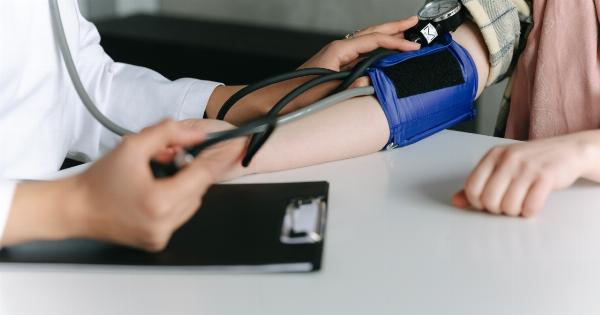Hypertension, commonly known as high blood pressure, is a condition that affects millions of people worldwide. It is a chronic medical condition characterized by elevated blood pressure levels consistently exceeding the normal range.
While hypertension primarily affects the cardiovascular system, there is mounting evidence to suggest that it could also have an impact on other aspects of health, including the skin.
Understanding hypertension
To comprehend the potential link between hypertension and skin discoloration, it is crucial to have a basic understanding of hypertension itself. Blood pressure is the force exerted by the flowing blood against the walls of the arteries.
High blood pressure occurs when this force is consistently too high, putting extra strain on the heart and blood vessels. Over time, this strain can lead to serious health complications.
The link between hypertension and skin
While hypertension is primarily a cardiovascular condition, it can affect various organs and systems in the body. One such system is the skin, which serves as a reflection of our overall health.
Studies have suggested that there is a potential association between hypertension and skin discoloration.
1. Facial flushing
Facial flushing, or redness in the face, can be a common symptom of high blood pressure. This redness is often temporary and caused by the dilation of blood vessels in the face.
While facial flushing can be caused by various factors, including emotions, alcohol consumption, or certain medications, it is important to consider hypertension as a possible underlying cause.
2. Spider veins
Spider veins, also known as telangiectasia, are tiny, dilated blood vessels that appear close to the surface of the skin. These small red or purple veins may resemble a spider’s web, hence the name.
While spider veins can occur due to multiple factors, including genetics and hormonal changes, hypertension could also contribute to their development.
3. Skin discoloration
Hypertension has been associated with skin discoloration in certain cases. Skin discoloration commonly refers to areas of the skin that appear darker or lighter than the surrounding skin tone.
While the exact mechanism linking hypertension to skin discoloration remains unclear, it is believed that compromised blood flow or changes in blood vessel structure could play a role in this phenomenon.
4. Petechiae
Petechiae are small, pinpoint-sized spots that appear on the skin due to minor bleeding from broken capillaries. These spots are generally red or purple and do not fade when pressure is applied.
While petechiae can be caused by several factors, including trauma, infections, or medication side effects, they may also occur in individuals with uncontrolled hypertension.
5. Bruising
Individuals with hypertension may experience increased skin bruising. Bruises occur when blood vessels beneath the skin break or rupture, leading to discoloration.
Although bruising can happen as a result of injuries or certain medications, individuals with poorly controlled hypertension may be more susceptible to bruising even with minimal trauma.
6. Pale or grayish skin
In some cases, hypertension can cause the skin to appear pale or grayish. This change in skin color may be attributed to reduced blood flow or inadequate oxygen supply to the skin cells.
It is crucial to note that pale or grayish skin can also be indicative of other underlying health issues, and consultation with a medical professional is recommended for an accurate diagnosis.
7. Rash or hives
Hypertension may also lead to the development of a rash or hives on the skin. Rashes can present as red, itchy patches, while hives are raised, swollen areas that are typically itchy and pale in color.
Skin rashes and hives can have various causes, including allergies and infections, but if they occur alongside high blood pressure, it is essential to consider hypertension as a contributing factor.
8. Skin ulcers
In severe cases of hypertension, particularly when combined with other conditions such as diabetes or peripheral artery disease, skin ulcers may develop. Skin ulcers are open sores that can be painful and slow to heal.
These wounds typically occur on the lower legs and feet, where blood flow may be compromised. If left untreated, skin ulcers can result in infections and further complications.
9. Sweating
Excessive sweating or changes in perspiration patterns can also be associated with hypertension.
While sweating is a normal bodily function that helps regulate body temperature, individuals with high blood pressure may notice increased sweating even in non-strenuous situations. Sweating can be a result of an overactive sympathetic nervous system, which regulates blood pressure and sweat production.
10. Nail abnormalities
Hypertension has been linked to certain nail abnormalities, which can also impact the appearance of the skin around the nails. These abnormalities may include the presence of Beau’s lines, vertical ridges, or changes in nail color.
Although nail abnormalities may have multiple causes, their occurrence alongside hypertension should not be overlooked.
Conclusion
Hypertension, a condition characterized by elevated blood pressure levels, can potentially cause various skin-related manifestations.
These may include facial flushing, spider veins, skin discoloration, petechiae, increased skin bruising, pale or grayish skin, rash or hives, skin ulcers, sweating abnormalities, and nail abnormalities. However, it is important to note that these skin symptoms can also arise from other underlying health issues. Hence, consulting a medical professional is crucial in determining the accurate cause and appropriate management.





























